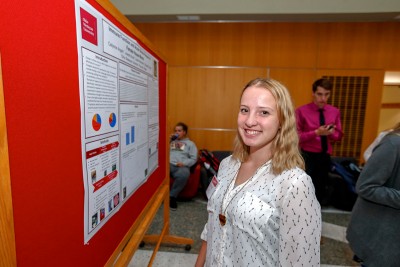It's Inauguration Day!
Congratulations, Matt vandenBerg, OWU's 17th President!
View details for Inauguration Day and stream the event live.
Congratulations, Matt vandenBerg, OWU's 17th President!
View details for Inauguration Day and stream the event live.

 Student: Cailynne Angelo
Student: Cailynne Angelo
Faculty Mentors: Elizabeth Schultz (OWU Department of Zoology) and Dustin Reichard (OWU Department of Zoology)
In any situation, organisms must work with limited resources and allocate a limited energy supply in order to adapt to their current surroundings. One important task that requires significant energy is maintaining immune function; however, when energy is more necessary elsewhere, less is available to support the immune system. We tested these energy trade-offs in nesting House Wrens (Troglodytes aedon) by creating a stressful situation for the parents and then measuring their immune response to E. coli, measuring the levels of stress hormones in their blood, and counting the number of white blood cells. This provides an idea of how the environment and other factors limit immune function and reproductive success in the wild.
Because energy is limited, animals must allocate it differently in order to adapt to varying circumstances. Levels of stress hormones such as corticosterone are documented as being inversely related to degree of immune function during periods of chronic or longterm stress, while acute or short-term stresses are predicted to elevate immune function. In this study, the trade-off between corticosterone and immune function was tested in female House Wrens (Troglodytes aedon) with 2-6 day old nestlings. Experimental trials included a simulated predation period using a model snake, a common nest predator, which was placed on top of a nest box. We then recorded behaviors such as flyovers, attacks, alarm calls, and amount of time spent within either 1m or 5m of the nest, for five minutes while the snake was presented. Once complete, the snake was removed and blood was collected within three minutes following the female’s capture, ranging from 0-20 minutes post-trial. From the blood, we measured bacterial killing ability using E. coli and conducted white blood cell counts using whole blood, and measured levels of corticosterone using plasma. Trials were then compared against a control group of females whose nests were not subjected to simulated predator presentation. Females in the control group were at the same nest-stage as the experimental group, and the blood sampling techniques remained the same as in the experimental trials. Results will provide insight into the environmental and physiological limitations of immunity and reproductive success in free-living animals.